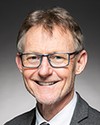Thank you very much, Mr. Chairman.
I'd like to thank the committee for this opportunity to discuss this very important issue.
The decision to participate in breast cancer screening or not should be up to individuals, but to inform that decision, they need accurate, unbiased and accessible information regarding the benefits, limitations and potential harms associated with screening. The Canadian Task Force on Preventive Health Care provides advice to primary care physicians and the public, but disturbingly, the information it provides has been distorted to discourage participation in breast cancer screening. This may be responsible in part for the low participation rates mentioned earlier by Ms. Van Dusen.
I am a senior breast cancer research scientist who leads a group of 20 researchers at the Sunnybrook Research Institute in Toronto. I also co-lead the imaging research program at the Ontario Institute for Cancer Research. Much of my work over the past 44 years has focused on breast cancer screening, and my group has helped develop and validate the technique of digital mammography that is now used worldwide. We established breast density as a risk factor for breast cancer. Also, in 2015, I helped write the World Health Organization's IARC handbook on breast cancer screening.
I've been at odds scientifically with the task force since 2011.
Dr. Seely already mentioned the randomized trials conducted in the 1990s that proved earlier detection of breast cancer by mammography screening can help reduce breast cancer deaths. With the modern developments in both screening and breast cancer therapy, more recent large studies, including the one done in Canada that was mentioned earlier, show a 44% reduction in breast cancer deaths in women from the age of 40 onward participating in mammography screening. They have shown definitively that breast cancer screening of younger women saves lives. Certainly, this is a much larger benefit than was seen in earlier randomized trials conducted 40 to 60 years ago. In addition, screening detection of breast cancers in younger women can, in some cases, give them back 20 additional years of life to be with their families, in the workplace and interacting with society.
A decision on screening involves weighing the benefits of averting premature death against the limitations and possible harms. The task force has not done this. Instead, it's made blanket statements about harms, suggesting without evidence that they may approach or outweigh the benefits for younger women.
The task force commissioned a project to model screening outcomes. A table in its guidelines suggested very low benefits from screening younger women. However, we have not had the opportunity to see the details of how it did that work.
I published modelling results in 2015 and 2022, some using the same model as the Canadian task force, and the U.S. preventive services task force commissioned modelling to inform its 2024 guidelines update. Results coming from five NCI-funded models in the U.S. agree well with those from my lab. They show continuously increasing absolute and relative benefits of breast cancer mortality reduction when the starting age for screening is reduced to 40, the stopping age is increased to 79—in other words above 74, as we've been discussing—and screening is performed annually rather than every two years. The worst results are obtained when screening is done at three years, which is a strategy suggested by the Canadian task force with no evidence at all to support it.
Modelling allows us to weigh the benefits versus the possible harms of breast cancer screening, and it has shown that the net improvement in quality-adjusted years of life—I can talk about that later if you want—gained by screening increases when screening starts earlier, ends later and is annual. The benefits consistently dwarf the harms.
As an expert invited to the Ottawa evidence review and synthesis centre, I had the same experience as Dr. Seely of interference by the task force. Against the advice of invited experts, they focused on the older, now obsolete randomized controlled trial data, set arbitrary thresholds to assess the data and used too short an observation time to allow the full impact of the benefits to be measured.
The task force takes a “less is more” position toward screening, and this comes at the cost of thousands of lost lives, accompanied by increased morbidity due to later treatment of disease. Of course, the task force also insists on specifying outcomes only in absolute quantities, which minimizes the perceived level of benefit, especially for lay people. Two lives saved per thousand seems like a small benefit, but that represents a 40% mortality reduction and 470 or more deaths avoided each year in Canada.
It's apparent that the task force has a strong bias against screening or preventive medicine of any kind. Of course, nobody should be coerced into being screened. It's a personal decision, but impediments to access must be removed to provide equity in saving lives. No woman should ever be put in a position of having to debate with her doctor, who has been misinformed by the task force, that she should be able to access screening.
Thank you.



